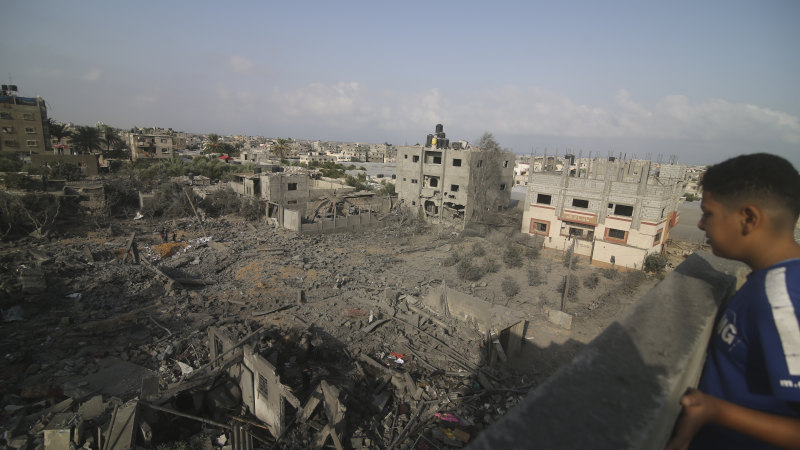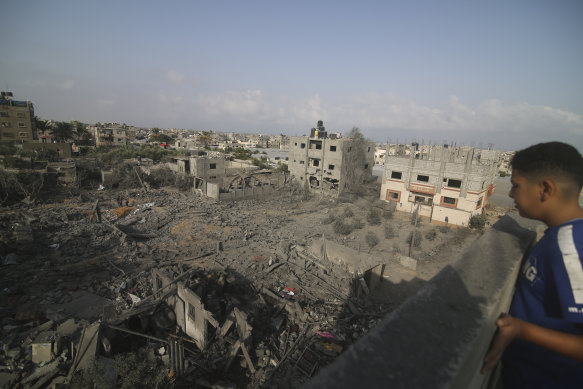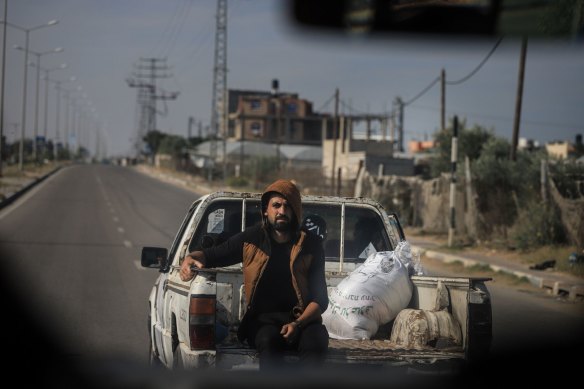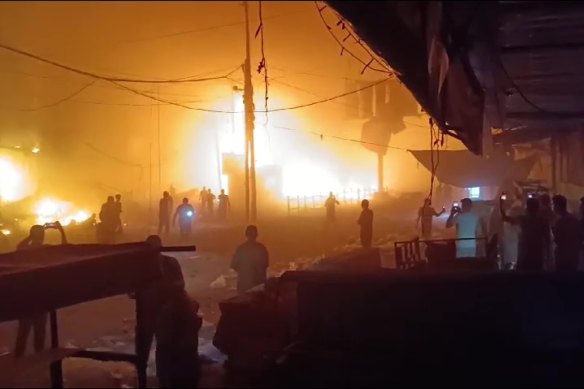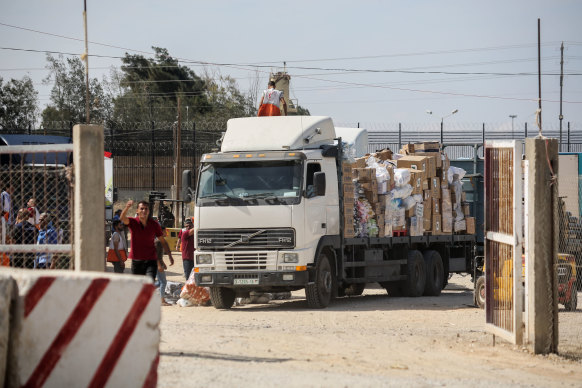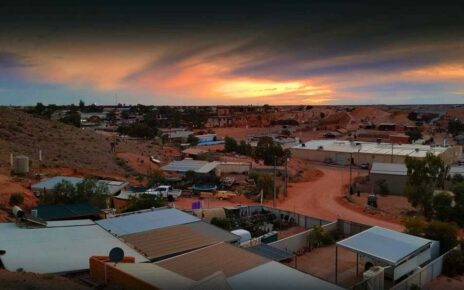Save articles for later
Add articles to your saved list and come back to them any time.
Rafah, Gaza Strip: Israeli warplanes struck targets across Gaza overnight and into Sunday, as well as two airports in Syria and a mosque in the occupied West Bank allegedly used by militants, as the two-week-old war with Hamas threatened to spiral into a broader conflict.
Israel has traded fire with Lebanon’s Hezbollah militant group on a near-daily basis since the war began, and tensions are soaring in the Israeli-occupied West Bank, where Israeli forces have battled militants in refugee camps and carried out two airstrikes in recent days.
A boy surveys destruction caused by Israeli bombardment of the Gaza Strip.Credit: AP
For days, Israel has seemed to be on the verge of launching a ground offensive in Gaza as part of its response to Hamas’ deadly October 7 rampage. Tanks and tens of thousands of troops have massed at the border, and Israeli leaders have spoken of an undefined next stage in operations.
But the military acknowledges there are still hundreds of thousands of Palestinian civilians in northern Gaza despite a sweeping evacuation order, which would complicate any ground attack. And the risk of triggering a broader war with Hamas’ allies in Lebanon and Syria might also give them pause.
On Saturday, 20 trucks of aid were allowed to enter Gaza from Egypt through the Rafah crossing, the first time anything has gone into the territory since Israel imposed a complete siege two weeks ago.
A Palestinian man rides on the back of a pickup truck in Rafah, Gaza, on Saturday.Credit: Bloomberg
Aid workers said it was far too little to address the spiralling humanitarian crisis in Gaza, where half the territory’s 2.3 million people have fled their homes. Hospitals packed with patients and displaced people are running low on medical supplies and fuel for generators, forcing doctors to perform surgeries with sewing needles, using kitchen vinegar as disinfectant, and without anaesthesia.
Shortages in supplies, including ventilators, are forcing doctors to ration treatment, said Dr. Mohammed Qandeel, who works in Khan Younis’ Nasser Hospital.
“It’s heartbreaking,” he told The Associated Press. “Every day, if we receive 10 severely injured patients we have to manage with maybe three or five ICU beds available.”
Palestinians sheltering in UN-run schools and tent camps are running low on food and drinking dirty water. The territory’s sole power plant shut down over a week ago, causing a territory-wide blackout and crippling water and sanitation systems. The UN humanitarian agency said cases of chicken pox, scabies and diarrhoea are on the rise because of the lack of clean water.
Gaza’s Hamas-run Interior Ministry reported heavy Israeli airstrikes across the territory overnight into Sunday, including southern areas where Israel had told Palestinians to seek refuge.
Late Saturday, an airstrike hit a cafe in the southern town of Khan Younis where displaced people had gathered to charge their phones. The nearby Nasser Hospital said 12 people were killed and 75 wounded.
Israel’s military has said it is striking Hamas members and installations, but does not target civilians. Palestinian militants have continued daily rocket attacks, with Hamas saying it targeted Tel Aviv early Sunday.
Israeli Prime Minister Benjamin Netanyahu convened his Cabinet late Saturday to discuss the expected ground invasion, Israeli media reported. A military spokesman, Rear Admiral Daniel Hagari, said Israel planned to step up airstrikes starting Saturday as preparation for the “next stages of the war.”
An Israeli ground assault would likely lead to a dramatic escalation in casualties on both sides. More than 1400 people in Israel have been killed in the war — mostly civilians slain during the initial Hamas attack. At least 210 people were captured and dragged back to Gaza, including men, women, children and older adults. Two Americans were released on Friday in what Hamas said was a humanitarian gesture.
More than 4300 people have been killed in Gaza, according to the Hamas-run Health Ministry. That includes the disputed toll from a hospital explosion.
Syrian state media meanwhile reported that Israeli airstrikes have targeted the international airports in the capital, Damascus, and the northern city of Aleppo. It said the strikes killed one person and damaged the runways, putting them out of service.
Israel has carried out several strikes in Syria, including on the airports, since the war began. Israel rarely acknowledges individual strikes, but says it acts to prevent Hezbollah and other militant groups from bringing in arms from their patron, Iran, which also supports Hamas.
In Lebanon, Hezbollah said six of its fighters were killed Saturday, and the group’s deputy leader, Sheikh Naim Kassem, warned that Israel would pay a high price if it starts a ground offensive in the Gaza Strip. Israel struck Hezbollah targets early Sunday in response to rocket fire, the military said.
Israel also announced evacuation plans for another 14 communities near the border with Lebanon. Kiryat Shmona, with a population of more than 20,000 people, was told to evacuate last week.
In the occupied West Bank, dozens of Palestinians have been killed in clashes with Israeli troops, arrest raids and attacks by Jewish settlers. Israeli forces have closed crossings into the territory and checkpoints between cities, measures they say are aimed at preventing attacks. Israel says it has arrested more than 700 Palestinians since October 7, including 480 suspected Hamas members.
The internationally recognised Palestinian Authority administers parts of the West Bank and cooperates with Israel on security, but it is deeply unpopular and has been the target of violent Palestinian protests.
Israeli forces killed at least five people early Sunday in the West Bank, according to the Palestinian Health Ministry. Two were killed in an airstrike on a mosque in the town of Jenin, which has seen heavy gunbattles between Palestinian militants and Israeli troops over the past year.
A screen grab captured from a video shows fire caused by Israeli airstrike on Nuseirat Refugee Camp in Gaza City, Gaza on October 21. Credit: Ramzi Adel/Anadolu via Getty Images
The Israeli military said the mosque compound belonged to Hamas and Islamic Jihad militants who had carried out several attacks in recent months and were planning another one.
Sunday’s fatalities brought the death toll in the West Bank to 90 Palestinians since the war broke out on October 7, according to the Health Ministry. Most appear have been killed during fighting with Israeli forces or violent protests.
Thirteen Palestinians, including five minors, and a member of Israel’s paramilitary Border Police were killed last week in a battle in a refugee camp in the West Bank town of Tulkarem, in which Israel also launched an airstrike.
In Gaza, the Israeli military said the humanitarian situation was “under control” as aid workers called for the opening of a round-the-clock aid corridor.
The first aid trucks arrive in Gaza, but the UN says 100 trucks are needed every day.Credit: Getty
The UN humanitarian agency, known as OCHA, said the convoy that entered Saturday carried about 4 per cent of an average day’s imports before the war and “a fraction of what is needed after 13 days of complete siege.” It is calling for 100 trucks a day to enter. Huge quantities of aid have been gathered near the Egyptian side of the crossing, but there has been no word on when more might enter.
No fuel has entered Gaza, even as hospitals are struggling to keep vital medical equipment running with generators. Dozens of patients continue to arrive each day, many with blast injuries from airstrikes.
Most treatment is carried out in crowded, darkened corridors, as hospitals preserve electricity for intensive care units and incubators for newborns. Nasser Hospital managed to secure some fuel from the UN agency for Palestinian refugees on Saturday, enough for three to five days, Qandeel said.
AP
More coverage of the Hamas-Israel conflict
- Cascading violence: Tremors from the Hamas attacks and Israel’s response have reached far beyond the border. But what would all-out war in the Middle East look like?
- The human cost: Hamas’ massacre in Israel has traumatised – and hardened – survivors. And in Gaza, neighbourhoods have become ghost cities.
- “Hamas metro”: Inside the labyrinthine network of underground tunnels, which the Palestinian militant group has commanded beneath war-ravaged Gaza for 16 years. The covert corridors have long provided essential channels for the movement of weapons and armed combatants.
- What is Hezbollah?: As fears of the conflict expanding beyond Israel and Hamas steadily rise, all eyes are on the militant group and political party that controls southern Lebanon and has been designated internationally as a terrorist group. How did it form and what does Iran have to do with it?
Get a note directly from our foreign correspondents on what’s making headlines around the world. Sign up for our weekly What in the World newsletter.
Most Viewed in World
From our partners
Source: Read Full Article
